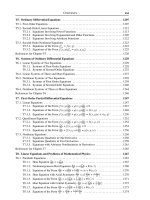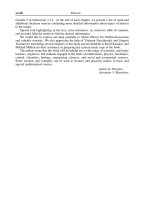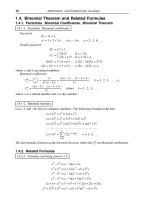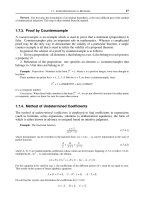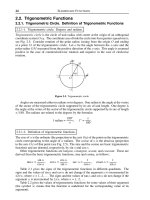Handbook of mathematics for engineers and sciente119 pptx
Bạn đang xem bản rút gọn của tài liệu. Xem và tải ngay bản đầy đủ của tài liệu tại đây (397.66 KB, 7 trang )
794 NONLINEAR PARTIAL DIFFERENTIAL EQUATIONS
Hence, the velocity vector for the continuous solution u(ξ) is a right eigenvector of
the matrix
G for any point u, and the corresponding eigenvalue equals the self-similar
coordinate:
ξ = λ
k
, u
ξ
= αr
k
.(15.14.4.66)
Here, λ
k
= λ
k
(u) is a root of the algebraic equation det |
G – λI| = 0, r
k
= r
k
(u) is a solution
of the corresponding degenerate linear system of equations
G – λI
r = 0,andα = α(u)is
a positive function that will be defined below.
Differentiating both sides of the first equation (15.14.4.66) with respect to ξ yields
α =
1
〈∇λ
k
, r
k
〉
, 〈∇λ
k
, r
k
〉 =
∂λ
k
∂u
1
r
k
1
+ ···+
∂λ
k
∂u
n
r
k
n
.
Any n × n hyperbolic system allows for n continuous solutions [of system (15.14.4.65)]
corresponding to n characteristic velocities λ = λ
k
. The continuous solutions are deter-
mined by n systems of ordinary differential equations. Each system is represented by a
phase portrait in the n-dimensional u-space. A solution/trajectory that corresponds to a
characteristic velocity λ
k
is called a kth rarefaction wave.
3
◦
. A trajectory of solution (15.14.4.47) in the space u =(u
1
, , u
n
)
T
is called a solution
path. The path is parametrized by the self-similar coordinate ξ. The path connects the
point u = u
L
with the point u = u
R
. The self-similar coordinate ξ monotonically increases
along the path varying from –∞ at u = u
L
to +∞ at u = u
R
. The path consists of con-
tinuous segments representing solutions of the ordinary differential equations (15.14.4.65)
(rarefaction waves), line segments that connect two points u
–
and u
+
satisfying the Rankine–
Hugoniot conditions (15.14.4.54) and evolutionary conditions (15.14.4.59), and rest points
u(ξ) = const.
Example 8. Consider a solution consisting of two shocks and one rarefaction. The structural formula*
for the solution path is u
L
→ 1 — 2 → u
R
; specifically,
u(x, t)=
⎧
⎪
⎪
⎪
⎨
⎪
⎪
⎪
⎩
u
L
if –∞ < x/t < D
1
,
u
1
if D
1
< x/t < λ
2
(u
1
),
u
(2)
(ξ)ifλ
2
(u
1
)<x/t < λ
2
(u
2
),
u
2
if λ
2
(u
2
)<x/t < D
2
,
u
R
if D
2
< x/t < ∞.
The shock speed D
1
(resp., D
2
) can be found from the Hugoniot condition by setting u
–
= u
L
and u
+
= u
1
(resp., u
–
= u
2
and u
+
= u
R
). Points 1 and 2 are located on the same rarefaction curve. The vector u
(2)
(ξ)isa
second-family rarefaction wave that is described by the system of ordinary differential equations (15.14.4.65)
with ξ = λ
2
(u).
Figure 15.10a depicts a sequence of rarefactions and shocks in the plane (x, t). Figure 15.10b shows the
profile of the solution component u
i
along the x-axis. The self-similar curves u = u(ξ) coincide with the
profiles u(x, t = 1). For t > 1, the graphs of u(x, t) are obtained from the self-similar curves by extending them
along the axis x by a factor of t.
Example 9. Let us discuss an adiabatic gas flow in a tube in front of an impermeable piston moving with a
velocity v
L
(see Fig. 15.11). The initial state is defined by prescribing initial values of the velocity and density:
v = 0, ρ = ρ
R
at ξ = ∞ (ξ = x/t). (15.14.4.67)
The piston is impermeable; therefore, the gas velocity in front of the shock is equal to the piston velocity
(Fig. 15.12a):
v = v
L
at ξ = v
L
.(15.14.4.68)
The gas density in front of the piston is unknown in this problem.
* In structural formulas like u
L
→ 1 — 2 → u
R
, the symbol “→” stands for a shock wave and “—” stands
for a rarefaction.
15.14. NONLINEAR SYSTEMS OF PARTIAL DIFFERENTIAL EQUATIONS 795
12
1
2
t
LR
R
u
i
L
x
x
0
0
()a
()b
Figure 15.10. Solution for the Riemann problem: (a) centered waves in the (x, t)plane;(b)theu
i
profile.
v
R
= 0, r
R
v
L
v
L
Figure 15.11. Constant velocity piston motion in a tube.
L
x = v
L
x = D
0
r
v
R
= 0, r
R
t
-
R
v
L
, r
L
v
L
vx v
R
= 0
-
-
()a ()b
Figure 15.12. Solution of the piston problem: (a) shock wave in the (x, t)plane;(b) shock locus in the phase
plane.
Figure 15.12b shows the locus of points that can be connected by a shock to the point (v
R
= 0, ρ
R
). This
locusisafirst-family shock. The intersection of the locus with the line v = v
L
defines the value ρ
L
. Hence, ρ
L
can be found from the equation
v
2
L
=
[p(ρ
L
)–p(ρ
R
)](ρ
L
– ρ
R
)
ρ
L
ρ
R
,(15.14.4.69)
which has been obtained by taking the square of equation (15.14.4.56). There exists a root ρ
L
of (15.14.4.69)
such that ρ
L
> ρ
R
. Hence, the gas is compressed ahead of the piston (Fig. 15.12a). The expression for the
shock speed can be found from the first Hugoniot condition (15.14.4.55):
D =
ρ
L
v
L
ρ
L
– ρ
R
> v
L
.(15.14.4.70)
The shock speed exceeds the piston velocity of (15.14.4.70) for ρ
L
> ρ
R
. Both characteristics of the first family
as well as the characteristic ahead of the shock from the second family arrive at the shock, so that the Lax
condition is satisfied. It can be proved that there are no other configurations that satisfy the initial-boundary
conditions (15.14.4.67), (15.14.4.68).
796 NONLINEAR PARTIAL DIFFERENTIAL EQUATIONS
15.14.5. Systems of Second-Order Equations of Reaction-Diffusion
Type
15.14.5-1. Traveling-wave solutions and some other invariant solutions.
In this subsection, we consider systems of nonlinear second-order equations
∂u
∂t
= a
1
∂
2
u
∂x
2
+ F
1
(u, w),
∂w
∂t
= a
2
∂
2
w
∂x
2
+ F
2
(u, w),
(15.14.5.1)
which often arise in the theory of mass exchange of reactive media, combustion theory,
mathematical biology, and biophysics.
It is apparent that systems (15.14.5.1) admit exact traveling-wave solutions
u = u(z), w = w(z), z = kx – λt,
where k and λ are arbitrary constants, and the functions u(z)andw(z) are determined by
the autonomous system of ordinary differential equations
a
1
k
2
u
zz
+ λu
z
+ F
1
(u, w)=0,
a
2
k
2
w
zz
+ λw
z
+ F
2
(u, w)=0.
Table 15.13 lists some systems of the form (15.14.5.1) admitting other invariant solu-
tions that are found using combinations of translation and scaling transformations in the
independent and dependent variables; these transformations preserve the form of the equa-
tions (i.e., a given system of equations is converted into an identical one). The procedure
for constructing such solutions for a single equation is detailed in Section 15.3.
TABLE 15.13
Systems of equations of the form (15.14.5.1) admitting invariant solutions that are found using
combinations of translation and scaling transformations (C is an arbitrary constant)
Systems of equations Invariant transformations Form of invariant solutions
∂u
∂t
=a
∂
2
u
∂x
2
+e
λu
f(λu–σw),
∂w
∂t
=b
∂
2
w
∂x
2
+e
σw
g(λu–σw)
t=C
2λσ
¯
t, x=C
λσ
¯x,
u= ¯u–2σ ln C,
w = ¯w–2λ ln C
u=y(ξ)–
1
λ
ln t, w =z(ξ)–
1
σ
ln t, ξ =
x
√
t
∂u
∂t
=a
∂
2
u
∂x
2
+u
1+kn
f
u
n
w
m
,
∂w
∂t
=b
∂
2
w
∂x
2
+w
1–km
g
u
n
w
m
t=C
–kmn
¯
t,
x=C
–
1
2
kmn
¯x,
u=C
m
¯u, w =C
–n
¯w
u=t
–
1
kn
y(ξ), w =t
1
km
z(ξ), ξ =
x
√
t
∂u
∂t
=a
∂
2
u
∂x
2
+uf
u
n
w
m
,
∂w
∂t
=b
∂
2
w
∂x
2
+wg
u
n
w
m
t=
¯
t+lnC,
x= ¯x+λ ln C,
u=C
m
¯u, w =C
–n
¯w
u=e
mt
y(ξ), w =e
–nt
z(ξ), ξ =x–λt
15.14.5-2. Generalized separable solutions.
In some cases, nonlinear systems admit generalized separable solutions of the form
u = ϕ
1
(t)θ(x, t)+ψ
1
(t),
w = ϕ
2
(t)θ(x, t)+ψ
2
(t),
(15.14.5.2)
where the functions ϕ
1
(t), ϕ
2
(t), ψ
1
(t), and ψ
2
(t) are selected so that both equations of
system (15.14.5.1) are reduced to one and the same equation for θ(x, t).
15.14. NONLINEAR SYSTEMS OF PARTIAL DIFFERENTIAL EQUATIONS 797
Example 1. Consider the system
∂u
∂t
= a
∂
2
u
∂x
2
+ uf(bu – cw)+g
1
(bu – cw),
∂w
∂t
= a
∂
2
w
∂x
2
+ wf(bu – cw)+g
2
(bu – cw),
(15.14.5.3)
where f(z), g(z), and h(z) are arbitrary functions.
Exact solutions are sought in the form (15.14.5.2). Let us require that the arguments of the functions
appearing in the system must depend on time t only, so that
∂
∂x
(bu – cw)=[bϕ
1
(t)–cϕ
2
(t)]
∂
∂x
θ(x, t)=0.
It follows that
ϕ
1
(t)=cϕ(t), ϕ
2
(t)=bϕ(t). (15.14.5.4)
Substituting (15.14.5.2), in view of (15.14.5.4), into (15.14.5.3) after elementary rearrangements, we obtain
∂θ
∂t
= a
∂
2
θ
∂x
2
+
f(bψ
1
– cψ
2
)–
ϕ
ϕ
θ +
1
cϕ
ψ
1
f(bψ
1
– cψ
2
)+g
1
(bψ
1
– cψ
2
)–ψ
1
,
∂θ
∂t
= a
∂
2
θ
∂x
2
+
f(bψ
1
– cψ
2
)–
ϕ
ϕ
θ +
1
bϕ
ψ
2
f(bψ
1
– cψ
2
)+g
2
(bψ
1
– cψ
2
)–ψ
2
.
(15.14.5.5)
For the equations of (15.14.5.5) to coincide, let us equate the expressions in square brackets to zero. As a result,
we obtain an autonomous system of ordinary differential equations for ϕ = ϕ(t), ψ
1
= ψ
1
(t), and ψ
2
= ψ
2
(t):
ϕ
= ϕf(bψ
1
– cψ
2
),
ψ
1
= ψ
1
f(bψ
1
– cψ
2
)+g
1
(bψ
1
– cψ
2
),
ψ
2
= ψ
2
f(bψ
1
– cψ
2
)+g
2
(bψ
1
– cψ
2
).
(15.14.5.6)
From (15.14.5.5)–(15.14.5.6) it follows that θ = θ(x, t) satisfies the linear heat equation
∂θ
∂t
= a
∂
2
θ
∂x
2
. (15.14.5.7)
From the first equation in (15.14.5.6) we can express the function ϕ via the other two:
ϕ = C
1
exp
f(bψ
1
– cψ
2
) dt
. (15.14.5.8)
(The constant of integration C
1
can be set equal to 1,sinceϕ and θ appear in the solution in the form of a
product.) As a result, we obtain an exact solution of system (15.14.5.2) in the form
u = ψ
1
(t)+c exp
f(bψ
1
– cψ
2
) dt
θ(x, t),
w = ψ
2
(t)+b exp
f(bψ
1
– cψ
2
) dt
θ(x, t),
(15.14.5.9)
where the functions ψ
1
= ψ
1
(t)andψ
2
= ψ
2
(t) are described by the last two equations of system (15.14.5.6),
and the function θ(x, t) is a solution of the linear heat equation (15.14.5.7).
Remark. Now we show how the functions ϕ(t)andψ(t), appearing in (15.14.5.9), can be found. Multiply
the second equation (15.14.5.6) by b and the third by –c and add up to obtain a separable first-order ordinary
differential equation for the linear combination of the unknowns:
z
t
= zf(z)+bg
1
(z)–cg
2
(z), z = bψ
1
– cψ
2
.(15.14.5.10)
Its general solution is expressed in implicit form as
dz
zf(z)+bg
1
(z)–cg
2
(z)
= t + C
2
.(15.14.5.11)
For given functions f(z), g(z), and h(z), from (15.14.5.11) we find z = z(t). Substituting it into the second
equation (15.14.5.6), we get a linear equation for ψ
1
. Solving this equation and taking into account the relation
for z, ψ
1
,andψ
2
in (15.14.5.10), we obtain
ψ
1
= C
3
F (t)+F (t)
g
1
(z)
F (t)
dt, ψ
2
=
b
c
ψ
1
–
1
c
z, F(t)=exp
f(z) dt
, z = z(t).
798 NONLINEAR PARTIAL DIFFERENTIAL EQUATIONS
Example 2. Consider now the system
∂u
∂t
= a
∂
2
u
∂x
2
+ uf
u
w
,
∂w
∂t
= a
∂
2
w
∂x
2
+ wg
u
w
.
An exact solution is sought in the form (15.14.5.2) with ϕ
2
(t)=1 and ψ
1
(t)=ψ
2
(t)=0.Aftersimple
rearrangements we get
u = ϕ(t)exp
g(ϕ(t)) dt
θ(x, t), w =exp
g(ϕ(t)) dt
θ(x, t),
where the function ϕ = ϕ(t) is described by the separable first-order nonlinear ordinary differential equation
ϕ
t
=[f(ϕ)–g(ϕ)]ϕ,(15.14.5.12)
and the function θ = θ(x, t) satisfies the linear heat equation (15.14.5.7).
The general solution of equation (15.14.5.12) is written out in implicit form as
dϕ
[f(ϕ)–g(ϕ)]ϕ
= t + C.
Exact solutions to some other second-order nonlinear systems of the form (15.14.5.1)
can be found in Subsection T10.3.1.
References for Chapter 15
Ablowitz, M. J. and Clarkson, P. A., Solitons, Non-Linear Evolution Equations and Inverse Scattering,
Cambridge University Press, Cambridge, 1991.
Ablowitz, M. J. and Segur, H., Solitons and the Inverse Scattering Transform, Society for Industrial and
Applied Mathematics, Philadelphia, 1981.
Ames,W.F.,Nonlinear Partial Differential Equations in Engineering, Vols. 1 and 2, Academic Press, New
York, 1967 and 1972.
Andreev, V. K., Kaptsov, O. V., Pukhnachov, V. V., and Rodionov, A. A., Applications of Group-Theoretical
Methods in Hydrodynamics, Kluwer Academic, Dordrecht, 1998.
Barenblatt, G. I., Dimensional Analysis, Gordon & Breach, New York, 1989.
Bluman,G.W.andCole,J.D.,Similarity Methods for Differential Equations, Springer-Verlag, New York,
1974.
Bluman,G.W.andCole,J.D.,The general similarity solution of the heat equation, J. Math. Mech.,
Vol. 18, pp. 1025–1042, 1969.
Bluman,G.W.andKumei,S.,Symmetries and Differential Equations, Springer-Verlag, New York, 1989.
Bullough,R.K.andCaudrey,P.J.(Editors),Solitons, Springer-Verlag, Berlin, 1980.
Burde, G. I., The construction of special explicit solutions of the boundary-layer equations. Steady flows,
Quart. J. Mech. Appl. Math., Vol. 47, No. 2, pp. 247–260, 1994.
Calogero, F. and Degasperis, A., Spectral Transform and Solitons: Tolls to Solve and Investigate Nonlinear
Evolution Equations, North Holland, Amsterdam, 1982.
Clarkson, P. A. and Kruskal, M. D., New similarity reductions of the Boussinesq equation, J. Math. Phys.,
Vol. 30, No. 10, pp. 2201–2213, 1989.
Conte, R. (Editor), The Painlev
´
e Property. One Century Later, Springer-Verlag, New York, 1999.
Courant, R. and Hilbert, D., Methods of Mathematical Physics, Vol. 2, Wiley-Interscience, New York, 1989.
Faddeev, L. D. and Takhtajan, L. A., Hamiltonian Methods in the Theory of Solitons, Springer-Verlag, Berlin,
1987.
Fushchich, W. I., Shtelen, W. M., and Serov, N. I., Symmetry Analysis and Exact Solutions of the Equations
of Mathematical Physics, Kluwer Academic, Dordrecht, 1993.
Galaktionov, V. A., Invariant subspaces and new explicit solutions to evolution equations with quadratic
nonlinearities, Proc. Roy. Soc. Edinburgh, Vol. 125A, No. 2, pp. 225–448, 1995.
Galaktionov, V. A., On new exact blow-up solutions for nonlinear heat conduction equations with source and
applications, Differential and Integral Equations, Vol. 3, No. 5, pp. 863–874, 1990.
Gardner,C.S.,Greene,J.M.,Kruskal,M.D.,andMiura,R.M.,Method for solving the Korteweg–de
Vries equation, Phys. Rev. Lett., Vol. 19, No. 19, pp. 1095–1097, 1967.
REFERENCES FOR CHAPTER 15 799
Ibragimov, N. H. (Editor), CRC Handbook of Lie Group Analysis of Differential Equations, Vols 1–3, CRC
Press, Boca Raton, 1994–1996.
Jimbo, M., Kruskal, M. D., and Miwa, T., Painlev
´
e test for the self-dual Yang–Mills equation, Phys. Lett.,
Ser. A, Vol. 92, No. 2, pp. 59–60, 1982.
Kudryashov, N. A., Analytical Theory of Nonlinear Differential Equations [in Russian], Institut kompjuternyh
issledovanii, Moscow–Izhevsk, 2004.
Loitsyanskiy, L. G., Mechanics of Liquids and Gases, Begell House, New York, 1996.
Novikov, S. P., Manakov, S. V., Pitaevskii, L. B., and Zakharov, V. E., Theory of Solitons. The Inverse
Scattering Method, Plenum Press, New York, 1984.
Olver, P. J., Application of Lie Groups to Differential Equations, 2nd Edition, Springer-Verlag, New York,
1993.
Ovsiannikov, L. V., Group Analysis of Differential Equations, Academic Press, New York, 1982.
Polyanin, A. D. and Zaitsev, V. F., Handbook of Exact Solutions for Ordinary Differential Equations, 2nd
Edition, Chapman & Hall/CRC Press, Boca Raton, 2003.
Polyanin, A. D. and Zaitsev, V. F., Handbook of Nonlinear Partial Differential Equations, Chapman &
Hall/CRC Press, Boca Raton, 2004.
Polyanin, A. D., Zaitsev, V. F., and Zhurov, A. I., Methods for the Solution of Nonlinear Equations of
Mathematical Physics and Mechanics [in Russian], Fizmatlit, Moscow, 2005.
Rogers, C. and Shadwick, W. F., B
¨
acklund Transformations and Their Applications, Academic Press, New
York, 1982.
Rozhdestvenskii, B. L. and Yanenko, N. N., Systems of Quasilinear Equations and Their Applications to Gas
Dynamics, American Mathematical Society, Providence, Rhode Island, 1983.
Schlichting, H., Boundary Layer Theory, McGraw-Hill, New York, 1981.
Sedov, L. I., Similarity and Dimensional Methods in Mechanics, CRC Press, Boca Raton, 1993.
Sidorov, A. F., Shapeev, V. P., and Yanenko, N. N., Method of Differential Constraints and its Applications
in Gas Dynamics [in Russian], Nauka Publishers, Novosibirsk, 1984.
Tabor, M., Integrability in Nonlinear Dynamics: An Introduction, Wiley-Interscience, New York, 1989.
Vinogradov, A. M., Local symmetries and conservation laws, Acta Appl. Math., Vol. 2, No. 7, pp. 21–78, 1984.
Weiss, J., The Painlev
´
e property for partial differential equations. II: B
¨
acklund transformation, Lax pairs, and
the Schwarzian derivative, J. Math. Phys., Vol. 24, No. 6, pp. 1405–1413, 1983.
Weiss, J., Tabor, M., and Carnevalle, G., The Painlev
´
e property for partial differential equations, J. Math.
Phys., Vol. 24, No. 3, pp. 522–526, 1983.
Whitham, G. B., Linear and Nonlinear Waves, Wiley, New York, 1974.
Zwillinger, D., Handbook of Differential Equations, 3rd Edition, Academic Press, San Diego, 1998.




